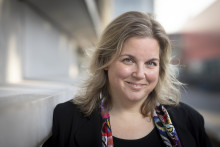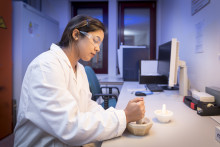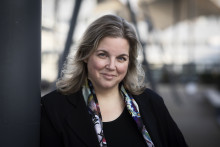The event addressed the topics of diversity and inclusion at the UT. It aimed to not only discuss how people of diverse cultures, genders and backgrounds can create a rich working environment, but also how we can create a culture where everyone feels welcome and at home.
‘Because diversity and inclusion are not the same thing,’ pointed out Michelle de Boer, HR Policy Advisor and one of the speakers at the event. ‘Diversity is about having a mix of people, but inclusion is about making the mix work and creating a sense of belonging for everyone.’
Inclusive Excellence
The first keynote speech of the conference was given by Professor Jennifer Herek, Dean of Faculty of Science and Technology at the UT. In her talk titled ‘Inclusive Excellence’, Herek shared her personal story as a scientist and her views on supporting talent at the UT.
‘We currently have an excellence model, which means supporting a group of good selected students as they strive for excellence,’ said Herek. ‘We might consider moving towards a “growth model” which would offer all students and staff the possibility to grow, be more aware of their opportunities and develop their own talents. We should be creating culture of being engaged and connected with each other. As the poet Maya Angelou wrote “In diversity there is beauty and there is strength”.’
The complexity of exclusion
Annalisa Pelizza, Associate Professor at the BMS faculty, was the second keynote speaker of the afternoon. She highlighted the complexity of the academic environment and that person’s exclusion is therefore based not purely on gender or ethnicity, but on a combination of factors.
‘Exclusion is also dependent on the historical and cultural situation,’ said Pelizza. ‘For example, gender wasn’t the main reason for exclusion at workplace at the beginning of the 20th century. Social class was a much more relevant category. That is why we should ask: What are the relevant categorical distinctions at the UT? There is already one directly in the university’s motto “High Tech, Human Touch”, which places a clear distinction between engineering and social sciences.’
‘You might suddenly realize you are a young woman’
‘How can the university address its employees in ways that foster a sense of inclusion?’ asked Pelizza. ‘Our identity is a temporary outcome of the ways we are addressed. We think of ourselves in the way people approach us. For example, you might suddenly realize that you are a young woman – simply because a more senior colleague assumes that you are too young to supervise a PhD candidate. Then you might feel different, excluded. We often put assumptions on our colleagues. We should take time to also verify if they see themselves the same way.’
Besides the talks, the FFNT conference featured a workshop ‘Inclusion: to belong or not to belong?’ led by Hélène Borgman from Talent naar de Top. The entire event ended with a drink to celebrate together the International Day of Women and Girls in Science.







